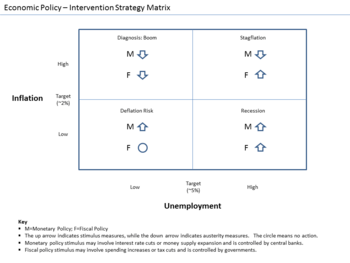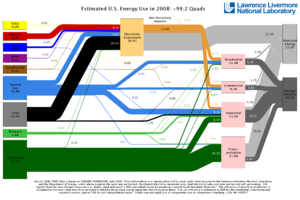Economic interventionism facts for kids
Economic interventionism, also called state interventionism, is an economic idea where the government steps into the market. The goal is to fix problems when markets don't work well. It also aims to help the general well-being of people.
An economic intervention is when a government or an international institution acts in a market economy. This goes beyond just stopping fraud or making sure contracts are followed. It also goes beyond providing basic public services. Governments might intervene for many reasons. These include helping the economy grow, creating jobs, or changing prices. They might also want to make income more equal or manage money.
The word intervention is often used by people who support a "hands-off" approach to the economy, known as laissez-faire or free market capitalism. The government is different from private businesses. It has special powers like making laws and using force. Private businesses follow rules about property law and contract law.
In capitalist economies, government actions can change how market forces work. This can happen through corporate welfare (like subsidies) or rules (like price controls). Sometimes, the government creates monopolies (like central banks). When governments intervene a lot, the economy might become a mixed economy. This means it has both private businesses and government involvement.
Contents
Different Views on Government's Role
Some people, like those who believe in free markets, think government involvement is usually bad. They worry about unintended consequences (unexpected problems). They also believe governments aren't good at managing economic issues.
However, others, like social liberals and social democrats, support government intervention. They see it as a way to make income more equal and improve social welfare (the well-being of people). Many center-right groups, like Christian democrats, also support government involvement. They believe it helps keep social order and stability. National-conservatives often support it too. They want to protect their country's power and wealth, especially by helping important industries.
On the other hand, some Socialists criticize interventionism. They think it might solve small problems for a short time. But they believe it can cause bigger problems in the long run. They argue that trying to fix problems in capitalism only creates new ones. For them, the only lasting solution is to replace capitalism with a socialist economy.
How Interventions Affect Things
People have different ideas about the effects of government economic intervention.
For example, in Latin America, many countries tried to open up their economies. This happened with help from groups like the International Monetary Fund (IMF) and World Bank. After a "lost decade" in the 1980s with a debt crisis and hyperinflation (very fast price increases), these groups pushed for changes. In Argentina, two big changes helped: increasing privatization (selling government businesses to private companies) and setting up a currency board (a system to keep money stable). This shows how global groups can encourage countries to open their economies. This can lead to more foreign investments and economic growth.
Governments often decide to intervene if the benefits for the public are greater than the costs. For example, during the financial crisis of 2007–2008, the U.S. government let Lehman Brothers go bankrupt. But days later, it spent public money to save American International Group (AIG). This shows that decisions can depend on how connected a company is to the state. In Japan, Abenomics is an example of intervention. Prime Minister Shinzō Abe wanted to bring back the country's economic strength.
Government Actions in the United States

The U.S. government has often intervened in the economy. For example, President Richard Nixon signed changes to the Clean Air Act in 1970. This law made states and the federal government regulate cars and factories. Other important environmental laws include the National Environmental Policy Act of 1969 (NEPA) and the Clean Water Act. These laws aim to protect the environment and control pollution.
During World War I, the U.S. government told car factories to make war machinery instead of cars. Today, some suggest the government could help reduce America's reliance on oil. They could do this by encouraging carmakers to produce more electric cars. For example, Michigan Governor Jennifer Granholm asked Congress for help. She wanted to renew tax credits for clean energy manufacturing.
Some people believe that a carbon tax (a tax on carbon emissions) could make electric cars more affordable. However, current plans suggest carbon prices would only slightly increase gasoline prices. This might not be enough to change how much fuel people use.
The U.S. government has also invested in car manufacturing. Since 2008, it has provided billions in public and private money for battery production. This could lower battery prices in the future. Some people disagree with a carbon dioxide emissions tax on new cars. They see it as a way for the government to raise money, not just to protect the environment. A national fuel tax means everyone pays based on how much they drive and the emissions they create.
During George W. Bush’s presidency, he promised to invest in clean coal technology. Congress passed the Energy Policy Act of 2005. This law funded research into capturing and burying carbon from coal. The coal industry received $9 billion in government help under this act. This was meant to reduce America's dependence on foreign oil and lower carbon emissions.
The American Clean Energy and Security Act, also known as the Waxman-Markey bill, passed in 2010. This bill aimed to greatly reduce carbon dioxide emissions after 2020. The goal was an 83 percent reduction from 2005 levels by 2050. The Environmental Protection Agency estimated that the cost of permits for emissions would rise over time.
The Obama administration also proposed cutting about $2.3 billion in coal subsidies. This was part of a plan to reduce government financial help for coal between 2011 and 2020.
Types of Government Rules and Help
Healthcare Systems with Government Rules
Some countries have healthcare systems where insurance companies must accept all customers. This is part of a public basic insurance policy. It means everyone gets treated equally, and all necessary healthcare is covered. This basic health insurance might be required for everyone in a country. For example, in the Netherlands, insurance companies get extra money from taxes. This system has been very good at getting rid of waiting lists for healthcare.
However, this system has some effects:
- It creates a large market for healthcare services for people with this public insurance. But it can make it harder for people to get medical services if they want to pay for them privately without a doctor's referral. This can reduce the market economy in healthcare.
- The income of people working in this system (like doctors and hospital staff) doesn't directly depend on supply and demand. This can be a problem in big medical emergencies. In these situations, the workers' jobs don't depend on serving patients, which is different from how a free market usually works.
|
See also
 In Spanish: Intervencionismo para niños
In Spanish: Intervencionismo para niños
- American School (economics)
- Austrian School
- Crowding out
- Deficit spending
- Developmentalism
- Dirigisme
- Indicative planning
- Keynesian economics
- Monetary policy
- National debt of the United States
- Planned economy
- Regulatory economics
- Rent-seeking
- Sales tax
- Social interventionism



